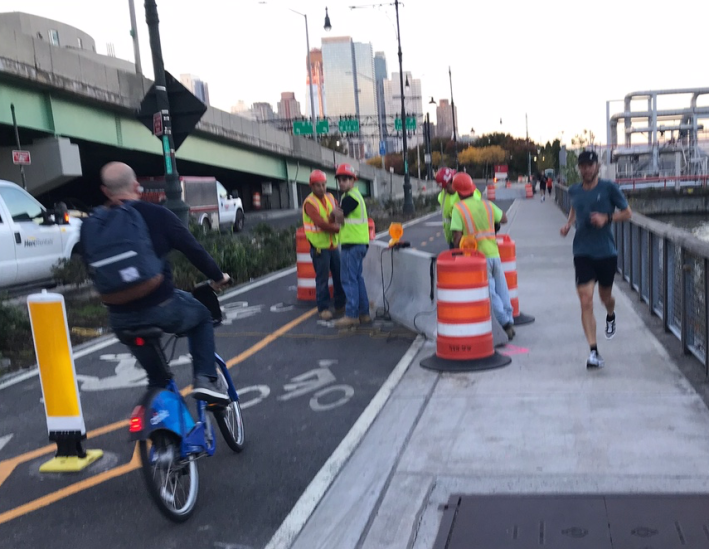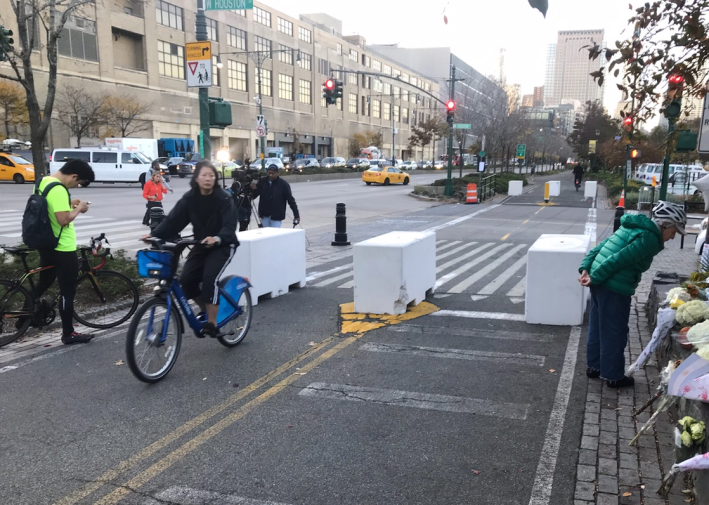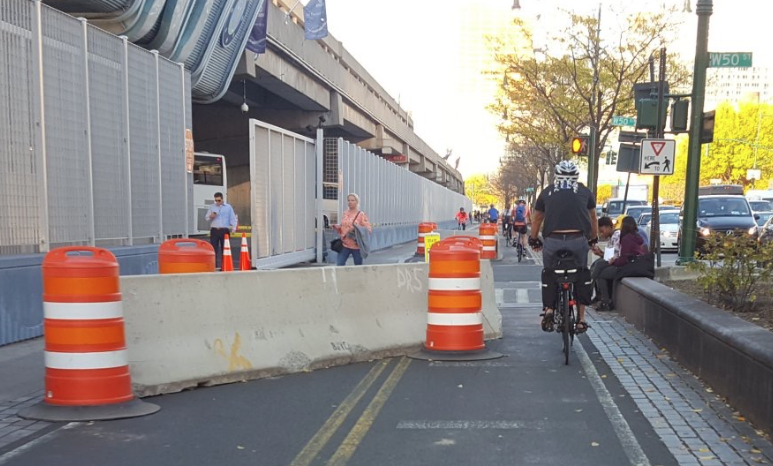The preventive measures installed after Tuesday's fatal attack have cut the width of the Hudson River Greenway in half at some locations, pinching the movement of cyclists and pedestrians on a crowded path used by thousands of people each day.
The greenway is managed by a confusing array of state and city agencies. The new barriers and blocks are primarily the work of the state DOT and NYPD. In total, state DOT and NYPD fortified 57 crossings between 59th Street and the Battery, said NYC DOT spokesperson Scott Gastel.
At 31 locations where motor vehicles traverse the path, state DOT installed long jersey barriers, pictured above. These are the most obtrusive measures, narrowing the width of the path by several feet.
Even without these obstructions, the greenway can get crowded with cyclists, walkers, and joggers -- especially when people are passing each other. The jersey barriers not only funnel people uncomfortably close together, they also increase the potential for head-on conflicts between greenway users.

Additionally, at 26 pedestrian-only crossings, NYPD put down concrete cubes. While the cubes maintain two-way travel on the path, they also narrow it more than necessary:

At other locations, NYPD officers have parked their vehicles right in the middle of the path.
So is this pic.twitter.com/BbE5KOFkMK
— Caroline Samponaro (@carolinesampo) November 3, 2017
Constricting the greenway doesn't appear to concern city or state officials at the moment. "After these safety measures are installed, there may be areas at the intersections that will be more narrow than they used to be,” mayoral spokesperson Ben Sarle told the Times. "But, I would trade a little speed for substantially more safety any day."
The segment of the greenway below 59th Street is owned by the state, but operated and maintained by the Hudson River Park Trust. Signal timing and police enforcement along the route is the city's jurisdiction.
Streetsblog asked both state DOT and NYC DOT how long greenway users can expect the concrete barriers on the path, and whether they would pursue a less obtrusive solution. State DOT has yet to respond. NYC DOT didn't have a timetable.
"That is part of the ongoing discussion," Gastel said, in regards to whether the barriers are temporary or permanent. "These were the immediate measures taken for that section of Battery to 59th. Overall, the parties are going to look at the rest of the greenway and other public spaces as well for other necessary security measures."
In a statement, Transportation Alternatives called for the jersey barriers to be re-oriented immediately and demanded a specific schedule for the implementation of less obtrusive safety measures:
The 20 foot linear jersey barriers installed across the greenway by the Governor’s State DOT are particularly dangerous, as they are channeling two-way bike traffic into one lane, effectively putting north and southbound cyclists on a collision course.
The Hudson River Greenway is the busiest pedestrian and bike path in North America -- it is used and beloved by hundreds of thousands of New Yorkers every year, and the city and state’s current ‘solutions’ fail them in spectacular fashion. We need to protect our public spaces without making them uninviting and difficult to use.
‘Temporary’, as these barriers are purported to be, might as well be ‘forever’ in New York bureaucratic parlance. The city needs to publicly establish a hard timetable for removal of these barriers and implementation of more thoughtful solutions that maintain the safety and integrity of the greenway.
There are smart policies the city can instead implement right now -- like bollards -- that will largely and inexpensively eliminate the risk of traffic violence, without prioritizing fear over health and well-being. Until bollards can be installed, we insist that the State and the City refine the placement of their concrete blocks so that the integrity of the busiest bike path in the country can be maintained.
Greenway vulnerabilities have been known for many years. After a drunk driver killed Eric Ng while he was riding on the path in 2006, Transportation Alternatives recommended installing steel bollards at street and driveway crossings, but the various agencies responsible for the greenway didn't take the threat seriously until now.
These heavy-handed concrete obstacles are not the way to go. We don't need to ruin the greenway in order to save it.






